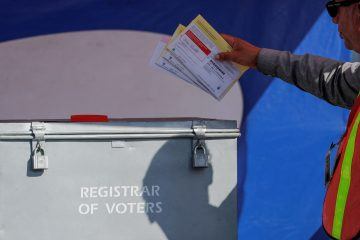Sue Halpern in The New Yorker:
 On Thursday, when Donald Trump casually suggested on Twitter that the November election be delayed because “Universal Mail-In Voting” would make it “the most INACCURATE & FRAUDULENT Election in history,” he was either setting the stage to contest the outcome or to explain away his impending defeat, or both. As the President should know by now, in-person voting during the coronavirus pandemic is dangerous, especially for older Americans and those with underlying health conditions. Yet he and his chorus of enablers have made a habit of trash-talking voting by mail, claiming, erroneously, that it promotes fraud. It’s no accident that Trump’s tweet specifically assailed “Universal Mail-In Voting,” since the word “universal” is triggering for anyone who is afraid of the will of the people.
On Thursday, when Donald Trump casually suggested on Twitter that the November election be delayed because “Universal Mail-In Voting” would make it “the most INACCURATE & FRAUDULENT Election in history,” he was either setting the stage to contest the outcome or to explain away his impending defeat, or both. As the President should know by now, in-person voting during the coronavirus pandemic is dangerous, especially for older Americans and those with underlying health conditions. Yet he and his chorus of enablers have made a habit of trash-talking voting by mail, claiming, erroneously, that it promotes fraud. It’s no accident that Trump’s tweet specifically assailed “Universal Mail-In Voting,” since the word “universal” is triggering for anyone who is afraid of the will of the people.
So far, only five states have nearly universal mail-in balloting. For most of them, it took years of legislative wrangling before it was adopted, and years of preparation before it was deployed. Additionally, thirty-four states and the District of Columbia have no-excuse absentee balloting (meaning that anyone can request an absentee ballot for any reason). And every state has the infrastructure to enable military and overseas voters to cast ballots from afar. (Inexplicably, according to Thursday’s tweet, Trump believes that absentee ballots are good and mail-in ballots are bad, even though they are the same thing.) All told, nearly eighty per cent of the electorate would be able to vote by mail in November.
Past primaries have offered a preview of the problems that can arise when significant numbers of voters choose this option. (Hint: the issue isn’t voter fraud.) Take California, a blue state, where over four million people voted by mail in February of 2008. The deluge was so great that election officials were still counting ballots weeks after the election. (One unexpected wrinkle: they had to iron thousands of ballots that had gotten crumpled in the mail, before they could feed them into the tabulator.) In New Jersey, another blue state, some voters found their ballots returned to them (and thus not counted) because the Postal Service scanned the wrong addresses; other citizens received hastily assembled ballots with the wrong slate of candidates. In New York City, where more than four hundred thousand ballots were cast by mail in the June primary, election officials do not expect to have a final vote tally for some jurisdictions until August. A hundred thousand have already been invalidated, some because they arrived too late, others because they weren’t signed or had a signature that didn’t match the signature on file.
These are some of the typical, non-malicious, ways that voters may find themselves disenfranchised.
More here.
